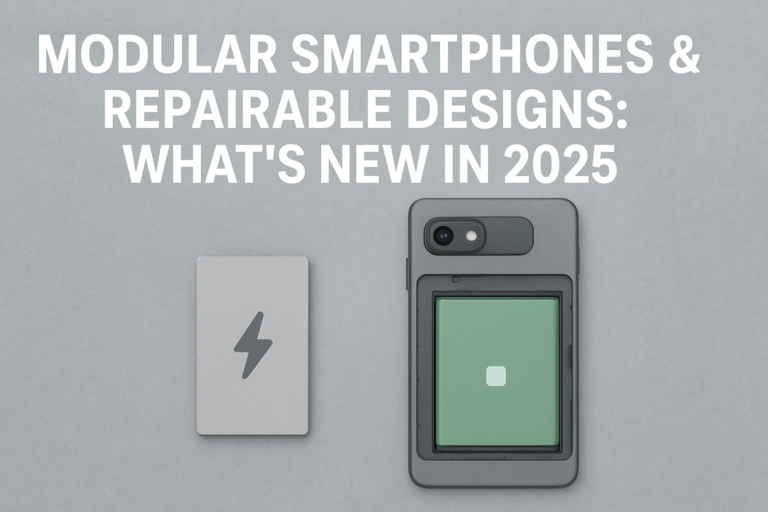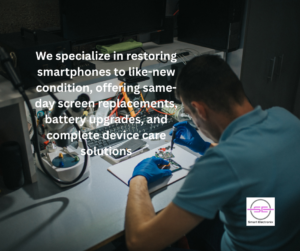
The smartphone industry has come a long way since the early days of sealed batteries and hard-to-fix glass backs. In 2025, the conversation is shifting once again, this time toward modular smartphones and repairable designs. The pressure from eco-conscious consumers, rising device costs, and growing right-to-repair awareness has pushed both established brands and new innovators to rethink how phones are built.
At Smart Electronix, we’ve always focused on repairability and sustainable tech. That’s why we’re excited about where the industry is heading in 2025 — a future where your smartphone can last longer, be upgraded piece by piece, and repaired quickly without breaking the bank.
The Evolution of Modular Smartphones
The idea of modular phones isn’t new. A decade ago, the tech world imagined Lego-style phones where every component could snap in and out. While that vision didn’t take off, it laid the foundation for a new era of practical modularity.
In 2025, modular smartphones are less about swapping dozens of tiny pieces and more about user-replaceable key parts like:
-
Batteries: No more glued-in units that fail after two years. Many new models now have easily accessible batteries that can be replaced in minutes.
-
Screens: Drop your phone? Instead of replacing the entire device, you can change the display without special tools.
-
Cameras & Ports: Frequent wear-and-tear areas like charging ports or camera lenses can be swapped out without dismantling the entire device.
This shift toward modular design is making repairs simpler and more affordable — exactly what repair shops like Smart Electronix specialize in.

Why Repairability Matters in 2025
For years, smartphones were becoming more fragile and expensive to repair. Sealed glass bodies, glued components, and software restrictions made simple fixes almost impossible outside official service centers. But 2025 marks a turning point.
Here’s why repairability is critical today:
-
Cost Savings – With flagship phones crossing $2000 AUD, replacing your device every two years is unrealistic for most Australians. Repairable designs cut costs by extending device life.
-
Sustainability – E-waste is one of the fastest-growing waste streams globally. Repairing instead of replacing reduces environmental impact.
-
Consumer Choice – Repairability empowers users to choose independent repair shops instead of being locked into expensive manufacturer repairs.
-
Resale Value – A repair-friendly phone maintains higher resale value because parts can be serviced or upgraded easily.
What’s New in 2025 Modular & Repairable Designs
2025 has already introduced several exciting innovations:
-
Hybrid Modular Designs – Instead of full modularity, many brands now offer hybrid approaches where critical parts (battery, screen, camera) are modular while core hardware remains fixed.
-
Durable Frames & Connectors – New materials make modular connections sturdier, preventing the fragility issues earlier modular phones faced.
-
Software Support for Repairs – Manufacturers are finally integrating diagnostics that help identify failing components, allowing repair shops to replace only what’s necessary.
-
Third-Party Parts Ecosystems – More suppliers are producing compatible parts, making high-quality replacements easier to source.
These updates mean your next phone could easily last five to seven years with proper care and maintenance.
Australia’s Role in the Repair Movement
In Australia, the right-to-repair conversation has been gaining momentum. Consumers are demanding more control over their devices, and repair businesses are stepping up to meet that demand.
For Australian users, 2025 brings:
-
Greater Access to Spare Parts – Distributors are now shipping more components locally, reducing wait times.
-
Independent Repair Growth – Shops like Smart Electronix are helping customers keep their phones in use longer.
-
Eco-Friendly Awareness – More people are choosing repair over replacement to reduce waste.
This cultural and market shift aligns perfectly with the push for modular designs.

How Smart Electronix Supports Repairability
At Smart Electronix, our mission is to keep your devices working as long as possible. With modular smartphones gaining traction in 2025, here’s how we can help:
-
Battery Replacements – We can quickly swap failing batteries in modular phones, giving your device a second life.
-
Screen Repairs – Modular designs make screen replacements faster and more affordable.
-
Upgrades & Customization – Some modular devices allow upgrades (better cameras, improved storage), and we can help with installation.
-
Diagnostic Services – Our team uses advanced tools to pinpoint failing components, saving you from unnecessary replacements.
-
Sustainability Options – We also refurbish older phones, giving them another chance to serve new owners.
Looking Ahead: The Future of Modular Tech
So what’s next? Here’s what we expect by the end of 2025 and beyond:
-
Mainstream Adoption – More mid-range and premium models will include modular repairable designs as standard.
-
Regulation Pressure – Governments will likely require manufacturers to support repairability with accessible parts and documentation.
-
Consumer Education – Buyers will start checking “repair scores” before purchasing, similar to how they compare battery life or camera quality today.
-
Expansion Beyond Phones – Modular principles are expected to spread to laptops, tablets, and even wearables.
Conclusion
2025 is a turning point for smartphones. After years of increasingly sealed, fragile devices, the industry is finally embracing repairability and modularity. For Australians, this means lower costs, reduced e-waste, and more control over how we use and maintain our devices.
